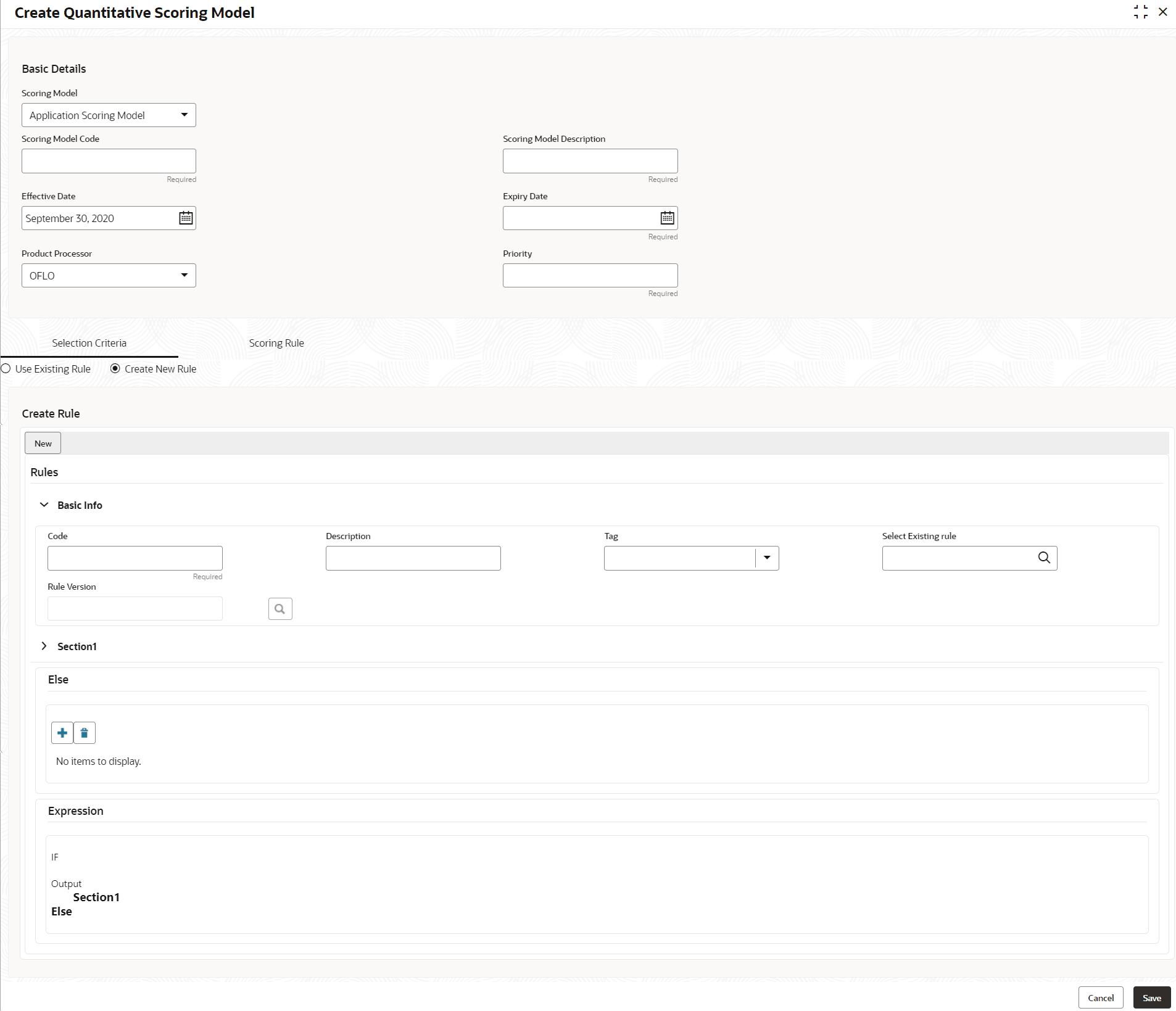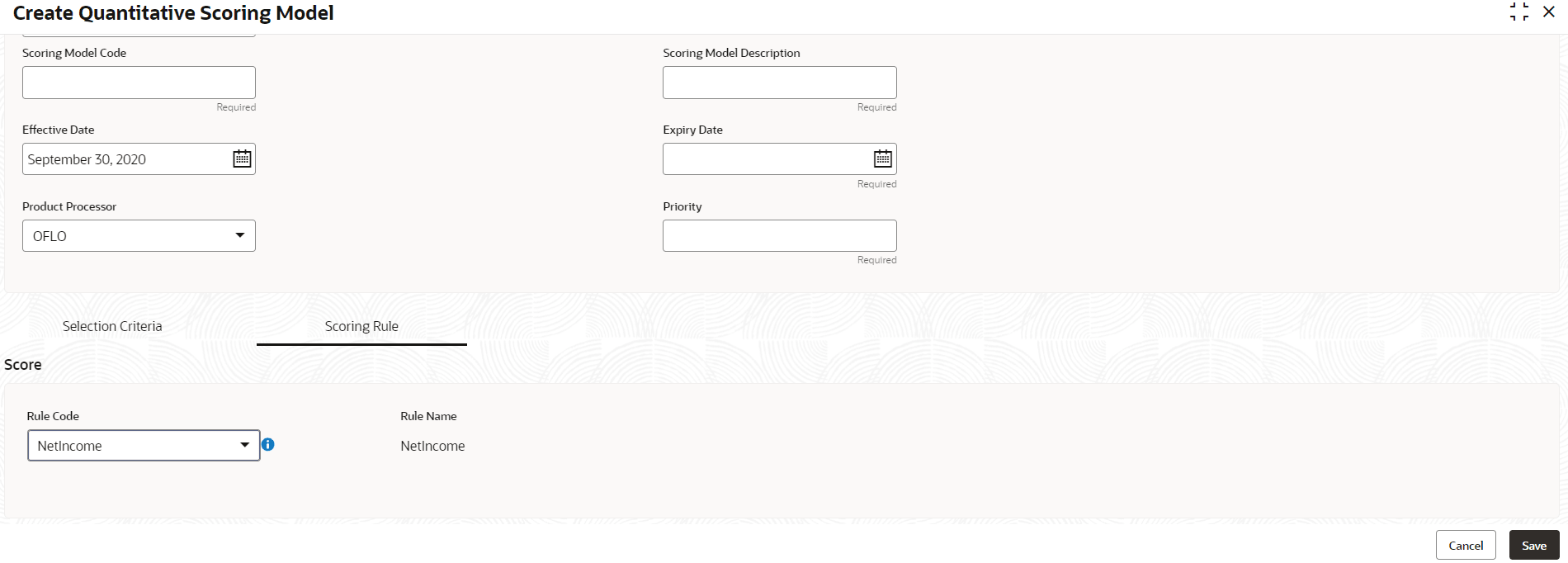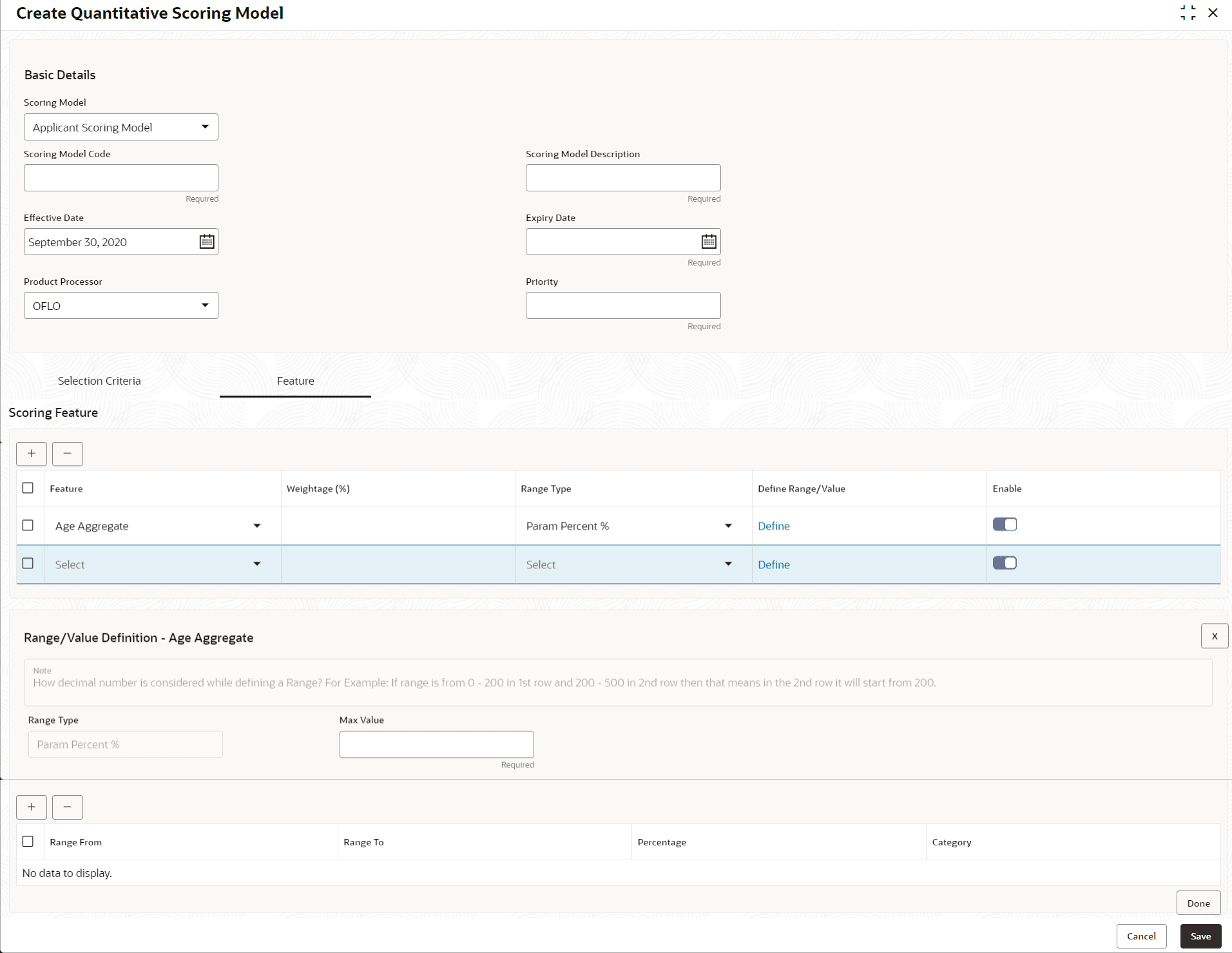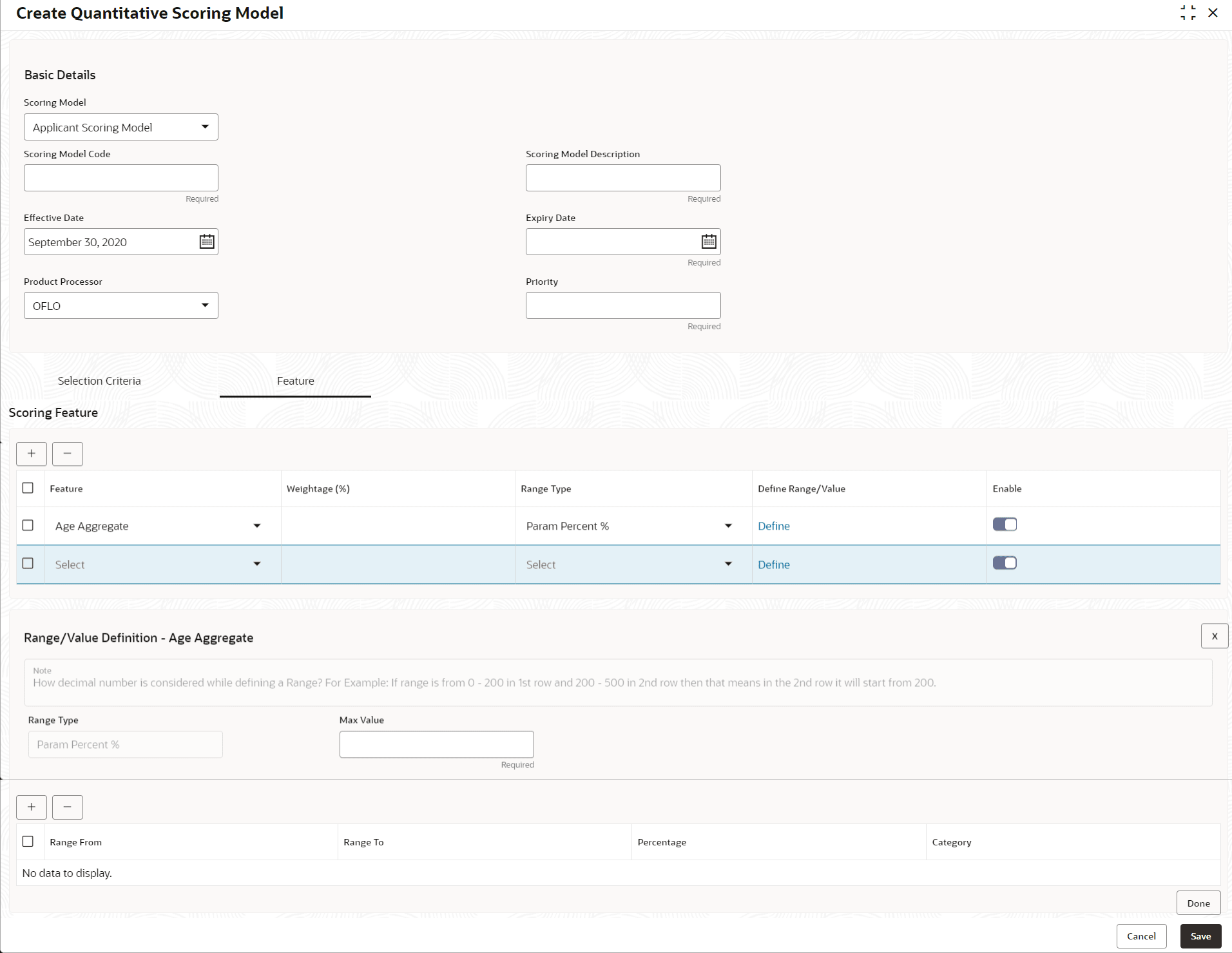- Oracle Banking Common Core User Guide
- Decision Service
- Quantitative Scoring Model
- Create Quantitative Scoring Model
3.10.1 Create Quantitative Scoring Model
This topic describes the systematic instructions to configure the quantitative scoring model based on the various scoring parameters.
- On Homescreen, click Core Maintenance, under Core Maintenance, click Credit Decision.
- Under Credit Decision, click Maintenance, under Maintenance, click Quantitative Scoring Model, under Quantitative Scoring Model, click Create Quantitative Scoring Model.The Create Quantitative Scoring Model screen displays.
Figure 3-34 Create Quantitative Scoring Model
- On Create Quantitative Scoring Model screen, specify the fields.For more information on fields, refer to the field description table.
Note:
The fields marked as Required are mandatory.Table 3-32 Create Quantitative Scoring Model - Field Description
Field Description Scoring Model Select the scoring model from the drop-sown list. The available options are:- Application Scoring Model
- Applicant Scoring Model
- Multi-Applicant Scoring Model
Scoring Model Code Specify the unique scoring model code. Scoring Model Description Specify a short description for the scoring model. Effective Date Specify the effective date. Expiry Date Specify the expiry date. Product Processor Specify the product processor for which the model is being created. Priority Specify the priority of the model. - Click the Selection Criteria to define quantitative scoring model.The Create Quantitative Scoring Model - Selection Criteria screen displays.For more information on fields, refer to the field description table.
Figure 3-35 Create Quantitative Scoring Model - Selection Criteria
Table 3-33 Create Quantitative Scoring Model - Selection Criteria - Field Description
Field Description Use Existing Rule By default, this option is enabled. Indicates if the existing rule is linked. Rule Code Select the rule code from the drop down list. 
Click this icon to get the information about the existing rule. Rule Name Displays the rule name of the selected rule code. Create New Rule Select this option to create new rule. Code Specify the rule code. Description Specify the rule description. + icon Click this icon to add new expression. Fact / Rules Select the fact or rule from the drop-down list. Once the user selects the fact/rules, one more field opens adjacent to the output, update the same based on the selected output option.
Operator Select the comparison operator from the drop-down list. The available options are:- <
- >
- +
- =
- %
- !=
- -
- >=
- <=
- *
- /
- Contains
- In
- Matches
- NotMatches
- NotContains
- Notin
Data Type Select the data type for the fact or rule. Once the user select the data type, one more field opens adjacent to the output, update the same based on the selected output option.
The available options are:- Text
- Number
- Boolean
- Date
- Fact
- Rules
The below option appears if the Data Type is selected as Boolean.- True
- False
Output Select the output from the drop-down list. Once the user select the data type, one more field opens adjacent to the output, update the same based on the selected output option.
The available options are:- Text
- Number
- Boolean
- Date
- Fact
- Rules
The below option appears if the Data Type is selected as Boolean.- True
- False
Expression Displays the expression updated in the expression builder. - Click the Scoring Rule to define the rules. This tab is enabled if Application Scoring Model is selected.The Create Quantitative Scoring Model - Scoring Rule screen displays.For more information on fields, refer to the field description table.
Figure 3-36 Create Quantitative Scoring Model - Scoring Rule
Table 3-34 Create Quantitative Scoring Model - Scoring Rule - Field Description
Field Description Rule Code Select the rule code from the drop-down list. 
Click this icon to get the information about the rule. Rule Name Displays the rule name of the rule code. - Click the Feature tab to define the feature. This tab is enabled if Applicant Scoring Model and Multiple Applicant Scoring Model is selected.The Create Quantitative Scoring Model - Feature screen displays.For more information on fields, refer to the field description table.
Figure 3-37 Create Quantitative Scoring Model - Feature
Table 3-35 Create Quantitative Scoring Model - Feature - Field Description
Field Description + icon Click this icon to add a new row. - icon Click this icon to delete a row, which is already added. Feature Select the feature from the drop-down list. Weightage (%) Specify the weightage to be assigned to each feature code. Range Type Select the range type from the drop down list.
The available options are:- Max Value
- Param Percent%
- Value
For Applicant Scoring Model, this field is editable.
Define Range/Value Click the Define link to define the score for the expected response. Enable By default, this option is enabled. Indicates if the scoring parameter is enabled or not. - Click the Define link to define a range or absolute values for each scoring feature to be considered for scoring model and score for that range or value.In case the data type of feature is numeric such as Bureau score, the Create Quantitative Scoring Model - Define Link - Numeric Feature screen displays.For more information on fields, refer to the field description table.
Figure 3-38 Create Quantitative Scoring Model - Define Link - Numeric Feature
Table 3-36 Create Quantitative Scoring Model - Define Link – Numeric Feature - Field Description
Field Description Range Type Displays the range type selected. Max Value Specify the maximum value on which scoring has to be done, if range type ID is Max Value % or Param %. + icon Click this icon to add a new row. - icon Click this icon to delete a row, which is already added. Range From Specify the minimum range of value based on which scoring is to be done. Range To Specify the maximum range of value based on which scoring is to be done. Score/Percentage Specify the percentage to be assigned for each range or value, if range type is Max value % or Param %.
Specify the score to be assigned for each range or value, if range type is Value.Category Specify the category for each range or value from the drop-down list. The values are configurable based on the lookup values maintained. The available options are:- Strong
- Medium
- Weak
If the data type of feature is alphanumeric such as Employment Category, the below screen appears.
For more information on fields, refer to the field description table.Figure 3-39 Create Quantitative Scoring Model - Define Link –Alphanumeric Feature
Table 3-37 Create Quantitative Scoring Model - Define Link –Alphanumeric Feature - Field Description
Field Description Range Type Displays the range type selected. The default value for the same is Value. Max Value Specify the maximum value for the range type. + icon Click this icon to add a new row. - icon Click this icon to delete a row, which is already added. Value Specify the value of the feature. Score Specify the score assigned for each range value. Category Specify the category for each range or value from the drop-down list. The available options are:- Strong
- Medium
- Weak
- Click Done to save the data and close the range panel.
- Click Save to save the details.The Quantitative Scoring Model is successfully created and can be viewed using the View Quantitative Scoring Model screen.
Parent topic: Quantitative Scoring Model





